Recently I climbed Mt. Kilimanjaro in Tanzania for International Women’s Day with Whoa Travel, and I have to say it was one of the most epic moments of my life!
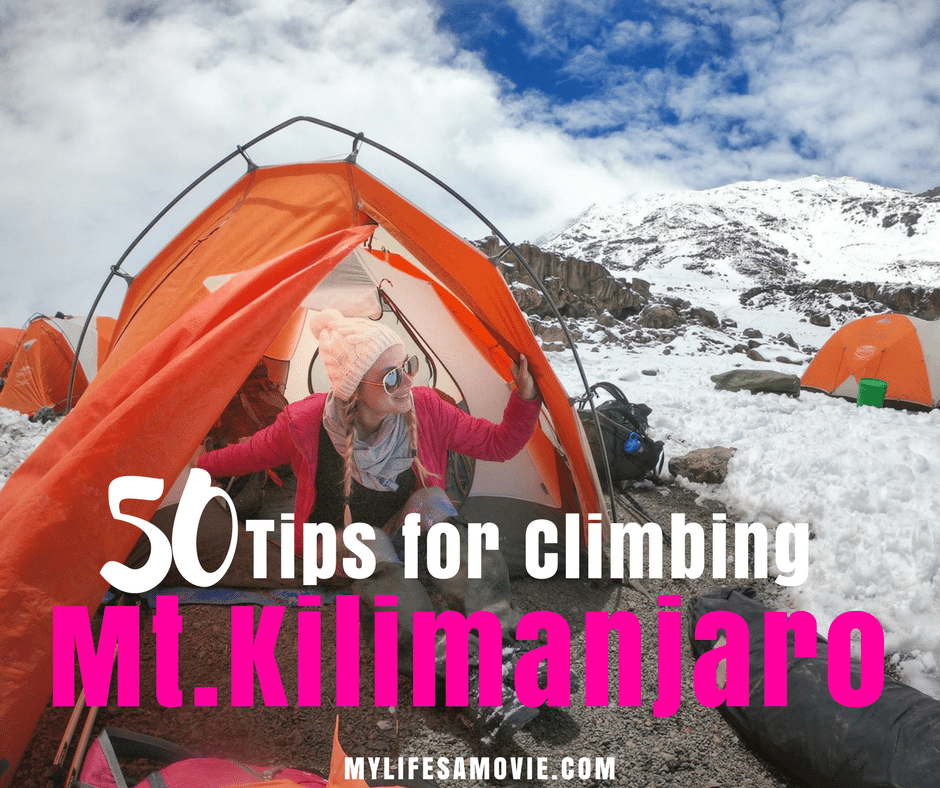
I’m by no means a professional hiker, but I honestly can say I didn’t find many difficulties with the climb up Kilimanjaro, and was actually the first one to reach the summit! The tips I have for you are based on my experience after a week of intense hiking, and embracing the entire camping/extreme trekking experience!
To make this post more legit though, I’m also adding in some tips from the girls who have summited multiple times, and from our guides who have done it over 400 times!
If you’re ready to book your bucketlist Kilimanjaro experience, I’d highly recommend doing it with Whoa Travel! You can even get $100 off using my code: ‘MyLifesATravelMovie’
Jump To:
1. Only Pack What They Tell You To
Good news, you don’t have to guess what to pack for your Kilimanjaro climb, because Whoa gives you a mandatory packing list, plus I have mine on here too! Of course, I added a few quirky/genius items that helped get me through the week!
Don’t feel pressured to buy all expensive, name-brand gear. Most of my stuff was just from Amazon, or I rented it for cheap from Whoa when I arrived. The most expensive things I bought were my hiking shoes and water bladder since those were the two things I knew I needed most!
2. Only Have Positive Thoughts
Everyone will tell you some statistic about the hike to Kilimanjaro being something% physical and somethingmore% mental. Usually I have no clue what people are talking about when they say that, but thinking back on my trek, I know I always was super excited and positive, and never once doubted getting up to the summit!
If you start to have a negative or doubtful thought about ANYTHING….STOP yourself, erase it, and think about unicorns flying high over the majestic clouds of the Kilimanjaro summit that you’re about to see. Or keep reminding yourself that this is going to be the most epic work out of your life, and you’re going to look bomb AF afterwards!
3. Embrace Peeing Outside

Just think of it as the most scenic bathroom you’ve ever been in. There’s plenty of privacy behind rocks and bushes, so just pick your spot, work those quads, and squat! For shy pee-ers, you’ll get over it quickly…or there’s also private porta-toilets at camp.
4. Pack Biodegradable Wipes (and a Black Ziplock)
You will NOT be leaving any trash on that mountain, including the wipes you use to go to the bathroom. But you’ll probably dump them out at camp toilets, so be nice to the Earth and get the biodegradable kind. Not leaving trash means you have to carry it, so do yourself a favor and find a black (or dark) ziplock bag to put them in so you don’t have to look at your used wipes.
Check out my full Kilimanjaro Packing Guide here!
5. Get Used to a Heavy Backpack
The only real pain I ever felt on the week long trek was on my shoulders/traps from carrying my day pack (backpack). I get the same pain though carrying my drone backpack/travel backpack, and I don’t have waist straps on any of those, so it could just be a personal problem.
To avoid it though, start getting used to carrying a heavy backpack, do shoulder strength building exercises, and maybe get a backpack with the waist strap (I was pretty fine not having one, but also needed a pack that I could collapse into my suitcase and keep traveling).
6. Slather on Sunscreen
The most terrifying thing I saw while trekking Kilimanjaro was how badly some people got sun burnt. You are very close to the sun AND on the equator. WEAR SUNSCREEN. Get SPF 50 or higher, preferably mineral-based, and slather it on EVERYWHERE. I kid you not, I got color on my shoulders and chest, even through multiple layers of clothing!
7. Get Crafty with Heaters
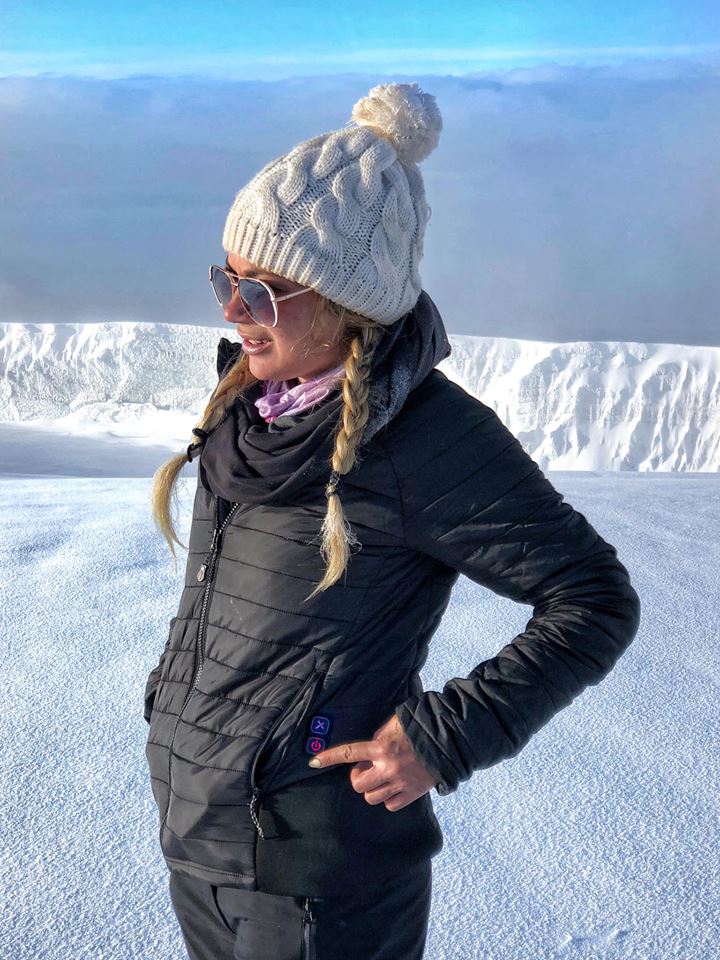
It gets really cold at night no matter when you go, and ESPECIALLY on summit night/morning. Layers and good socks and gloves are going to be your savior, but there’s a few other products that can keep you warm as well. I used air-activated hand warmers in the snow-zones and extra cold nights, and had them in my boots, gloves, and bra for summit.
I also am super fancy and geeky and found a self-heating jacket which was fantastic to have for summit, especially when I refused to keep my gloves on so I could take photos (the pockets are heated).
8. Download Music/Podcasts/Audio Books
Contributing your music playlist during long and difficult hike days will be much appreciated (usually a GAL has a portable speaker), but you may also want it to keep you focused and in the zone…or to fall asleep. There was also a girl who listened to a Harry Potter book during the 7 hour summit hike which she found useful!
9. Bring External Chargers
You can probably imagine how many photos and videos I take right? Running out of batteries was my number one fear, but it never even came close to happening. I used one 20,000 mAh power bank and it charged my iPhone X four times, and my GoPro’s 6 times. And it’s still not dead yet!
I brought two smaller cheap ones as well, one of which I gave to a guide, the other I let someone else use since I didn’t need it. That being said, sharing is caring!
10. Learn As Much Swahili As Possible
Words cannot describe how annoyed I was with the amount of people who hiked Kili once before and the only advice they could give was “Pole Pole!” It means “slowly slowly”, which isn’t even good advice, because that’s obvious and mandatory, and just shows they didn’t take the time to learn any more of the local language.
Your guides and porters are who are going to get you to the top of that mountain, so show some respect and learn some of their language! Below are some basic words and phrases:
Asante sana: Thank you very much
Karibu: Welcome (to a place or you’re welcome)
Mambo: What’s Up
Poa: Good
Pole: Sorry
Nina Luna: Good night
Twende: Let’s Go
Habari Gani: How are You?
11. Be Friendly to the Porters

It’s pretty heartbreaking seeing the porters carrying all of the trekking gear (and YOUR duffel bag) up the mountain, especially knowing they don’t get paid a TON to do it. But you have to remember that this job is probably the only way they can make money for their family, regardless of how strenuous it is on their bodies, and how long they have to be away from home.
You are already doing a good thing by doing the trek which contributes to their salary (and also with Whoa, they tips are included so they are ensured to make extra), but please go that extra mile and be friendly and encouraging to the porters when you see them. Learn their names, say hello, ask how they are (all in Swahili, see above!), and if you’re really awesome, bring a few extra snacks or gifts from the U.S for them! More on this later regarding a fundraiser I’m going to do for porters!
12. ONLY Trek With a KPAP Approved Company
KPAP stands for “Kilimanjaro Porters Assistance Project” which is a non-profit organization that makes sure porters are given fair wages, appropriate clothing and gear to wear, and adequate food to eat during their treks. Companies that are NOT a part of KPAP are known to pay porters next to nothing and even worse, not even feed these hard working people more than two meals per day!
Never ever use a company to climb Kilimanjaro unless they are on this list: KPAP Approved Kilimanjaro Companies. Whoa Travel is listed on there under U.S. companies, and so is the local company they outsource from called Trek 2 Kili!
13. Take the Diamox
Usually I avoid taking meds if I’m not sick, but I will 100% back that taking the anti-altitude sickness medicine called Diamox was an absolute must. I took it preventatively (125mg twice a day and I just bought them from a pharmacy in Moshi before the trek), and never once felt sick aside from a slight headache after the summit.
Diamox gives you slight finger and/or toe tingles and makes you have to pee more, but I gladly took those side effects instead of dealing with the symptoms of altitude sickness (puking, nausea, headache, feeling like death).
14. Get to Moshi/TZ Early to Adjust to Time
I realized on the second day of the trek that I had a slight advantage over most of the group because I had already been in Africa for a few weeks before the trek. Everyone coming from the U.S. was 11 hours behind and had to factor in jet lag, which most didn’t leave room for since they arrived the day before the hike. If you can, try to get to Moshi or Tanzania in general a few days early to adjust.
15. Bring Your Favorite Snacks from Home
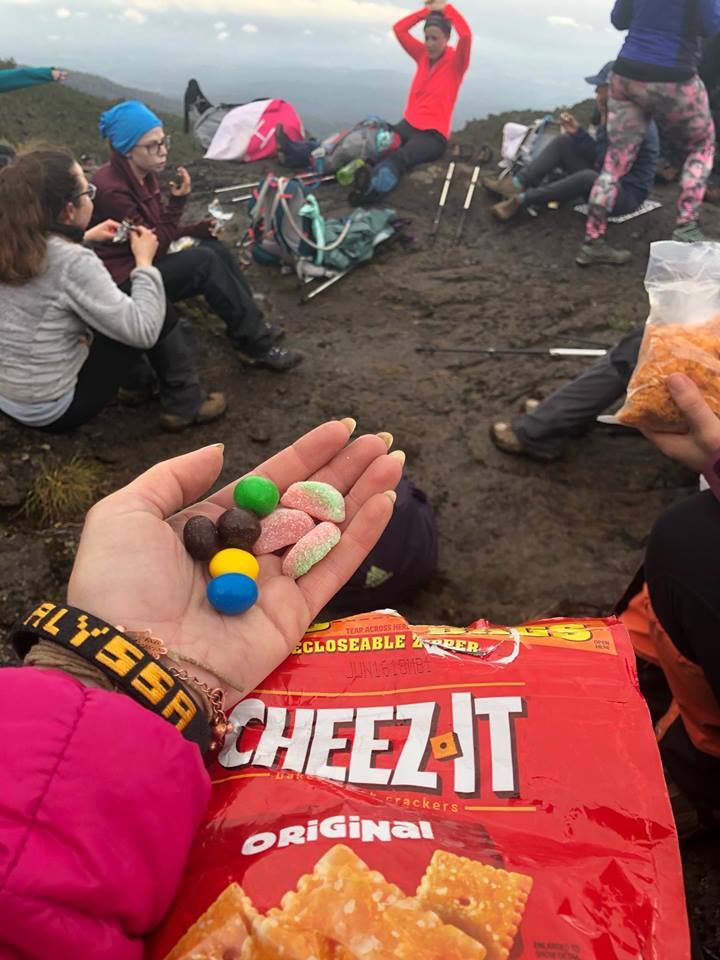
My only disadvantage compared to everyone else was that I couldn’t bring my favorite snacks from the U.S. since I was traveling before the trek. You may think protein bars are the only things you need to pack, but you have no idea how motivating snacks like Cheese-itz, Gushers, Goldfish, Starbursts, Snickers and any other candy can be!
Buy extra and share! Especially with the guides and porters, they’ll love you forever! Big shout out to Anika who didn’t know me but brought me a bag of Cheese-Itz from the U.S., and all the other girls who shared their snacks with me!
16. Drink All the Water
You’ll be required to bring a 3L water bladder (AKA a camelback) as well as a water bottle (in case your bladder freezes on summit night), and the porters/staff will fill them all up every morning. You should try to drink all 3 liters. Yes that means you’ll have to pee more, but luckily you’ll take a lot of pee breaks anyway. Plus Diamox makes you pee and you’ll become dehydrated if you don’t restore your body with water.
Drinking a ton of water also prevents altitude sickness (cram those Oxygen molecules in ya!) not to mention is a great detox!
OH! And also a GREAT reason to drink a lot of water — the more you drink, the less heavy your day pack will be!!!
17. Eat All the Food
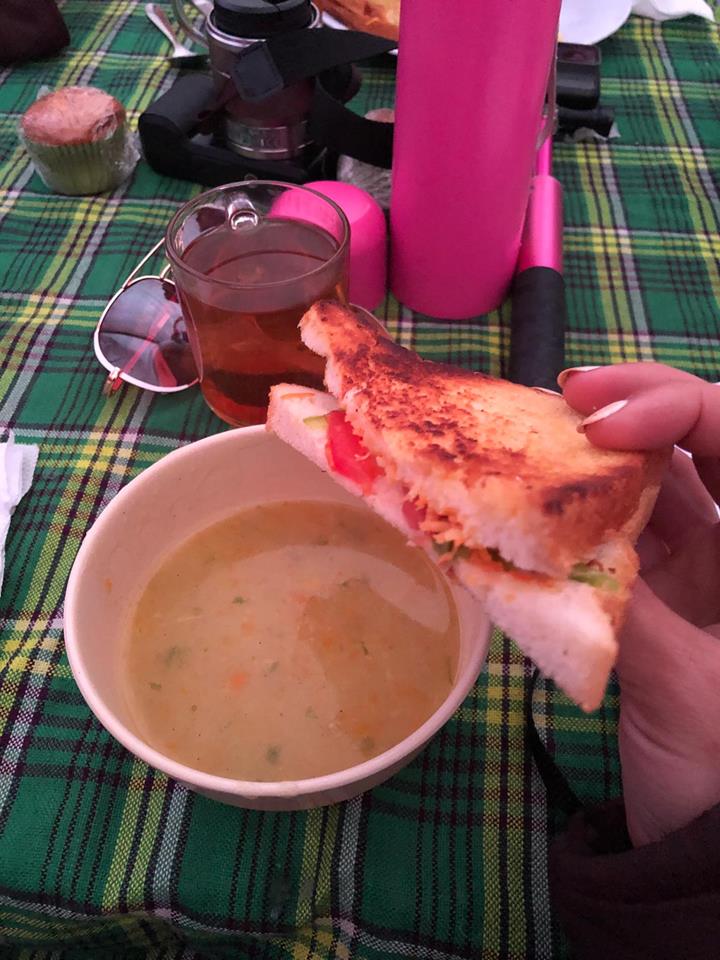
Also something you won’t really have a choice about since you’ll get called out by the guides and servers if you don’t finish your food! They do this because you really do need that nourishment and energy for the hikes. You burn A LOT of calories and energy and if it’s not replenished, you’ll just get tired and sick.
The meals on the trek are shockingly delicious (considering the chefs are cooking in a tent and using food that has been carried for days and strategically frozen according to which day it’ll be used), especially the soups, so you’ll want to eat a lot anyway!
18. Use Panty-Liners to Keep Underwear Clean
Sounds weird, but it works, and it’s genius. Of course bring enough clean underwear for the trip, but believe me when I say that some nights you will be too tired and cold to want to take off allllll your layers to even change underwear. Panty liners can easily be put in and taken out in the private portable toilets you’ll have at camp!
19. Dry Shampoo, Baby Powder, Braids and Hats
IF you’re even concerned about what your hair/appearance looks like, this is for you. I do, and I couldn’t stand all the sunscreen and vaseline getting in my hair, so I dumped baby powder in it to dry it out. I also wore a hat every single day which looked way cuter than my gnarly hair.
I also just kept my hair in two low braids which was easiest to manage, while still attempting to look somewhat put together. I also used the baby powder in my boots to keep them dry and not as smelly.
20. Bring Coco Butter Vaseline
Your skin gets really dry during the Kilimanjaro hike, and especially if your sunburnt (I was REALLY burnt from Kenya before my trek). I used Coco Butter Vaseline on my super chapped/wind burned lips, dry skin, and because it smelled good which masked the inevitable stench of camping and hiking for a week.
21. Bring Earplugs and an Eye Mask
You hear and see EVERYTHING when you’re in a tent. Which kind of sucks when you need to sleep a lot in order to do your hike early in the morning. You’ll be pretty tired from hiking and hopefully will just pass out on your own, but earplugs and an eye mask worked wonders.
22. Think of it as the Best Workout of Your Life
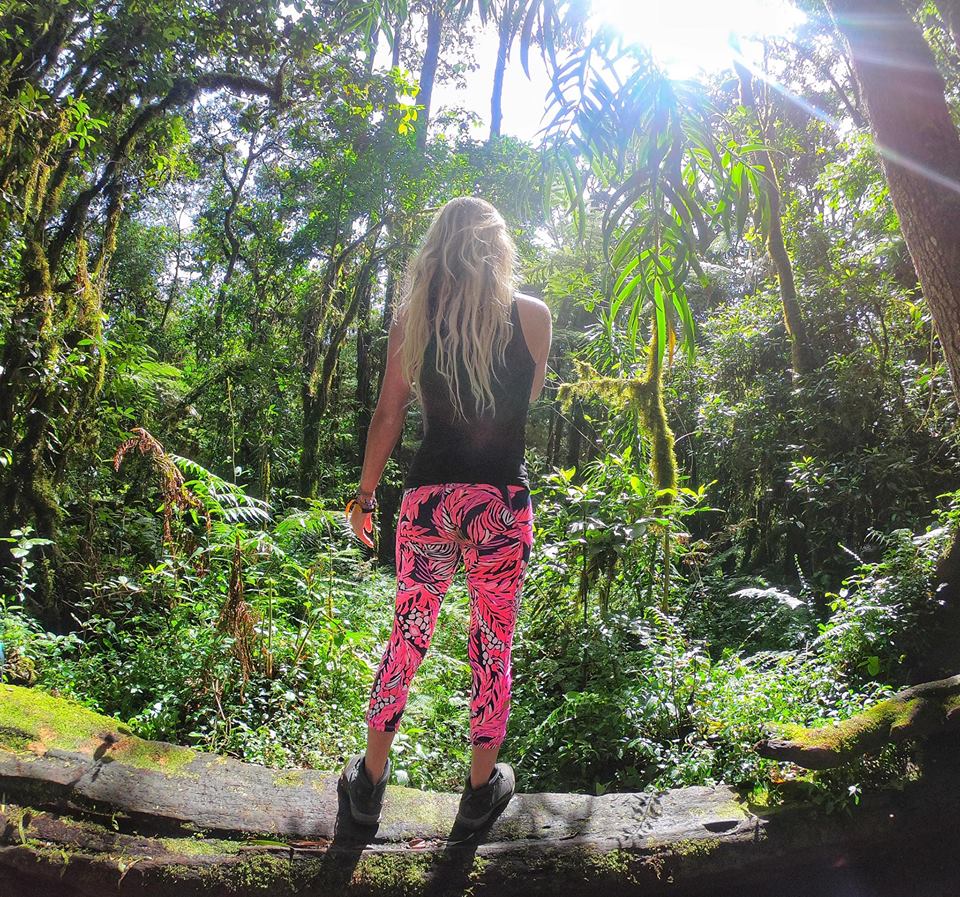
There will be times during your Kilimanjaro trek when your legs, back, and other muscles hurt. Instead of complaining, whining, or worrying, just keep convincing yourself it’s leg-day and/or core day. I actually would flex and tighten my glutes and abs while walking to get extra workouts since I had to walk anyway, and I stepped off that mountain in the best, most muscular shape of my life!
23. Always Wear Sunglasses in Snow
It doesn’t always snow on Kilimanjaro (we just got super blessed with about a meter of it…), but if there’s any snow at all on the ground, you MUST wear sunglasses. Sun blindness is a real thing (one of the porters got it because he forgot sunglasses), and the brightness can also give you a severe headache.
24. Keep Clothes, Socks, and Damp Items in Your Sleeping Bag
Mornings are chilly, so if you want to avoid having to put on cold clothes, just sleep with them in your sleeping bag! If you have damp socks or clothes from hiking, you can also put them in your sleeping bag and it will dry them out quicker. Don’t expect anything to get dry just by hanging it in the tent!
25. Fill Empty Space in Sleeping Bag to Stay Warm
If you’re cold at night and find there’s a lot of empty space in your sleeping bag, try filling the empty space with clothes or whatever items you can find to fill the space. I rented a fleece sleeping bag liner which helped a lot, and would get in that first, then fill the sides of the sleeping bag with clothes so it tucked me in.
26. Fill a Water Bottle or Bladder with Warm Water in Sleeping Bag to Stay Warm
On the coldest night of the trek I could not manage to make myself warm, so I decided to fill my water bladder 1/3 full with hot water from the communal tea/coffee water dispenser in the mess tent. I then placed the mini-water bed on my chest and put my hands over it and was able to stay warm most of the night, plus had fresh water to drink in the morning.
27. Keep Batteries/Cameras/Phones in Sleeping Bag or On You
In case you didn’t already know; your batteries and phone die significantly faster when you’re in cold weather. Since most nights and some days are pretty cold, and you won’t have access to outlets, you need to do everything possible to keep them alive.
At night, sleep with all of your batteries, phones, and cameras in your sleeping bag to keep them warm. While hiking, keep them in pockets close to your body or even in your bra.
28. Use Poncho For Extra Warmth
If you’re REALLY cold, at night or while hiking, putting your mandatory poncho on can help trap body heat in. They aren’t exactly the easiest things to hike in or the most comfortable things to sleep with, but if you want to stay warm, you gotta do what you gotta do!
29. For Period-Havers, Use a Diva Cup
Praise the universe I did not have my period during the 8 day trek to Kilimanjaro, but if you happen to get yours, I’d highly suggest using a Diva Cup. Diva Cups are silicone little cups that catch your period blood and only need to be emptied 1-2 times per day. They’re super comfortable, hygienic, and you don’t have to worry about running out of them!
NOTE: The altitude may cause your period to come early! So even if you aren’t expecting it, plan for it just in case!
30. Bring Protein Bars!
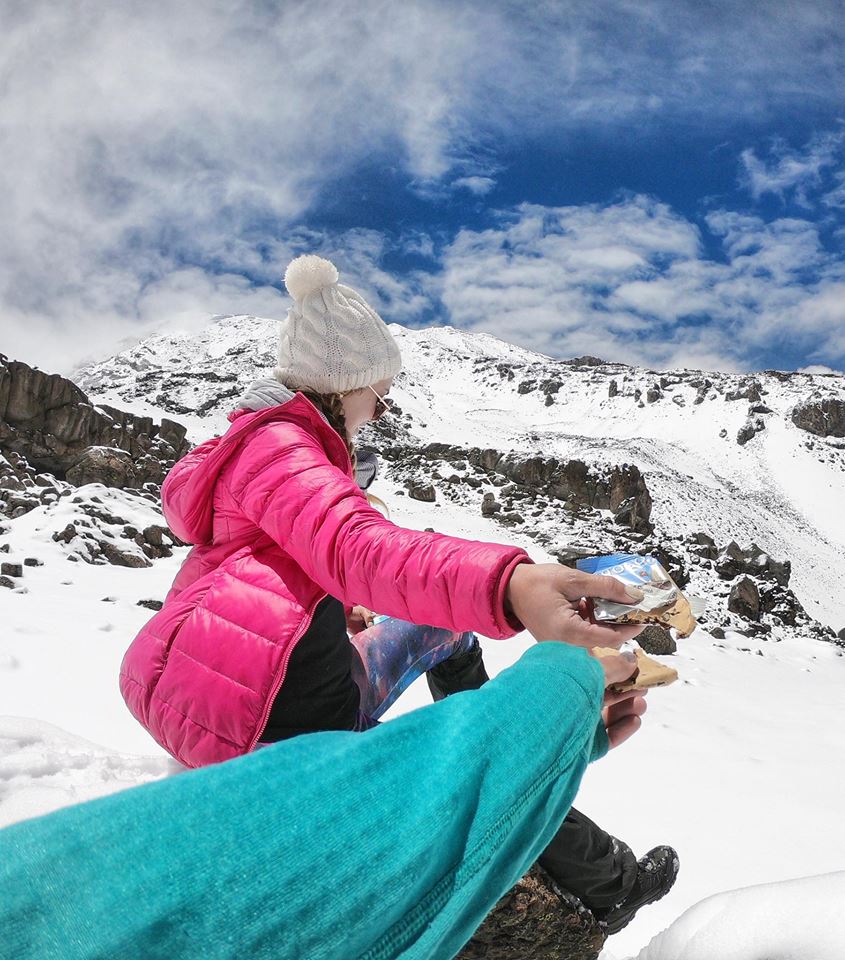
Sometimes you may feel like you’re running low on energy during the hikes, or you may have a lack of appetite due to the altitude. Protein bars solve both of those problems, and are easy to carry and eat as you hike. I ate about three protein bars during the entire summit day (12-14 hours total). My favorite kind of protein bars is Wolo Snacks since they actually taste good (peanut butter, chocolate mint, and coco crunch), have extra nutrients like Tumeric and Vitamin C, and have cute travel packaging.
31. Count Your Steps
My personal method of getting through those hard hiking days, especially summit night, is counting my steps. It distracts me from how much longer there is, and makes me focus on keeping a steady pace, which ends up matching my breathing.
This is literally what made the 7 hour summit climb fly by, because every time my guide (Geoffrey — big shout out for being awesome and also carrying my day pack up to summit) would announce how many meters high we were, I’d calculate how many steps were left, and just keep counting as I walked.
32. Keep Your Summit Clothes in a Dry Bag or Trash Bag
Throughout the week your clothes are going to get dirty, smelly, and damp. You do not want wet clothes on summit night/day because you will literally freeze and probably grow icicles (My hair grew icicles and it was dry!). To ensure you have at least a dry base layer, keep clothes specifically for summit in a dry bag or trash bag and don’t open it until it’s time to summit. I used travel compression bags for this!
33. Cut Your Toenails Before Summit Night
Sounds odd, but makes sense. After you get to the very top of the giant mountain, you’re going to have to come down, and going downhill means your feet will be sliding forward in your shoes. If your toenails aren’t trimmed, this can be extremely painful, so be sure to clip them the night before! (Nicole’s Tip)
34. Paint Your Nails Before the Trek
To be completely honest, I HATE getting my nails done. It takes forever and I get bored having to sit there and not work for over an hour. BUT I always make sure to get gel nail polish before big adventures, so I don’t have to worry about painful nail breaks, or disgusting crap under my nails.
Before the trek I had my nails done in Latvia and asked for an extra two coats of gel polish, and I shit you not, even three days after my Kilimanjaro hike now and not one of them has even chipped. (Nicole’s Tip)
35. Bring Less Wipes Than You Think You Need
The second non-helpful advice people usually give who have done the trek after “Remember, Pole Pole!”, is “Bring a lot of baby wipes!” I almost feel as if they do this to try and scare you or make you embarrassed about not showering for a week, but you definitely only need one package of wipes.
I brought two, only used one, and that extra space could have gone to an extra box of cheese-itz. (Nicole’s Tip)
36. Pack Your Camp Shoes in Your Backpack the Last Day
Most people may think going up hill is the hard part, but TRUST ME, the last day of walking downhill only for 4-6 hours is the worst of it. Your toes and thighs will hurt and you’ll want to take off your shoes IMMEDIATELY. Well at least most people will…apparently I’m some sort of beast and thought my hiking boots were still comfy to wear.
Anyway, you won’t get your duffel bag with all of your stuff in it until you get back to the hotel, so if you think you’ll want to change shoes, put them in your day pack on the last day! (Nicole’s Tip)
37. Wear Clean Socks for Summit
This was a strong recommendation from the guides, and not just because our feet were starting to stink! They say wear a clean pair of socks because there’s a good chance you’ll get blisters, and you don’t want the dirt, bacteria, and grossness from dirty socks getting in your body and infecting it.
They also say to wear as many socks as there’s space for in your boots on summit night, so what I did was wear a clean pair of basic ankle socks, with wool tights over them, then my SmartWool socks I wore the entire trip (yep, that’s right, one pair of socks the whole trip), and somehow I also managed to shove hand warmers on top of my toes in my boots too. (Guides tip and recommendation)
38. Don’t Bring a Big Camera
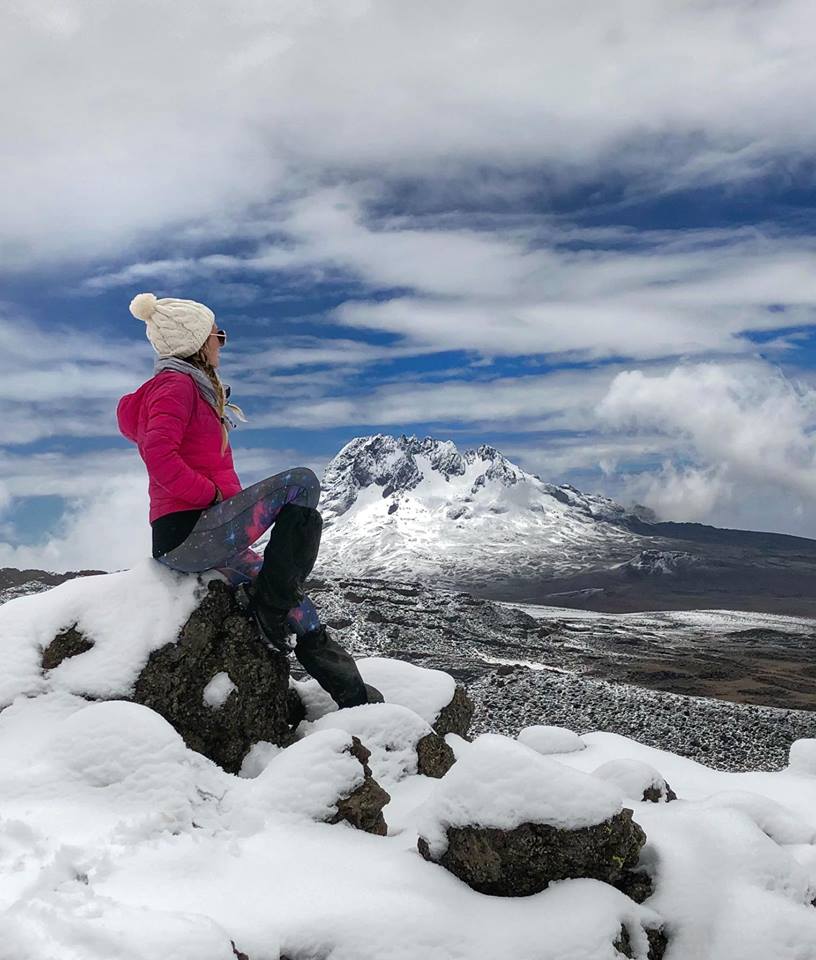
I was really glad to see this suggestion on the Whoa website, mostly because I don’t have a big fancy camera. There were only a couple of people who brought one, and they definitely didn’t use it as much as it was probably worth it to carry around for a week. You also won’t have a ton of time to stop and take photos as your hiking, and you probably won’t want to either since it’s exhausting.
I mostly used my GoPro and my iPhone X, and the photos all came out amazing. My group was also really awesome about snapping shots of each other and group shots, and we all just AirDropped them to each other at the end of the days.
39. Always Have Your Poncho & Gaiters Handy
They say Mt. Kilimanjaro is definitely a woman, and that she’s moody-AF, because the weather around her changes abruptly and dramatically. There was an ongoing joke that just to mess with us, when one person would take off their poncho, it would then purposely start to rain.
Then there’s also the fact that half of our summit photos are in front of the sign with blue clear skies behind us, and the other half has just a white sheet of clouds. So yeah, always have your poncho easily accessible.
Gaiters are something new that I didn’t know about before, but were mandatory on the packing list (I rented mine). They’re what I refer to as waterproof leg warmers, because they strap under your shoe, then wrap around the top of your foot, shin, and lower knee in order to keep your shoes and clothes clean from mud and water when you’re hiking. I personally thought they looked cute with my leggings so I just wore them every day…and had clean clothes every day.
40. Don’t Be Afraid to Ask Health Questions
Shit happens. Literally. A lot of people get diharrea from the Diamox meds or altitude, and at least three people will vomit towards the final days to summit. If something is going on, do not be afraid to ask questions about it to your guide or GAL. It’ll only hurt you if you don’t!
Plus, you’re going to have to get a health assessment each night by the guides anyway. They check your Oxygen levels and heart rate, then have you fill out info about your appetite, sleep, dizziness, headaches, and how much of the meds (Diamox) you’re taking.
41. Use Your Trekking Poles
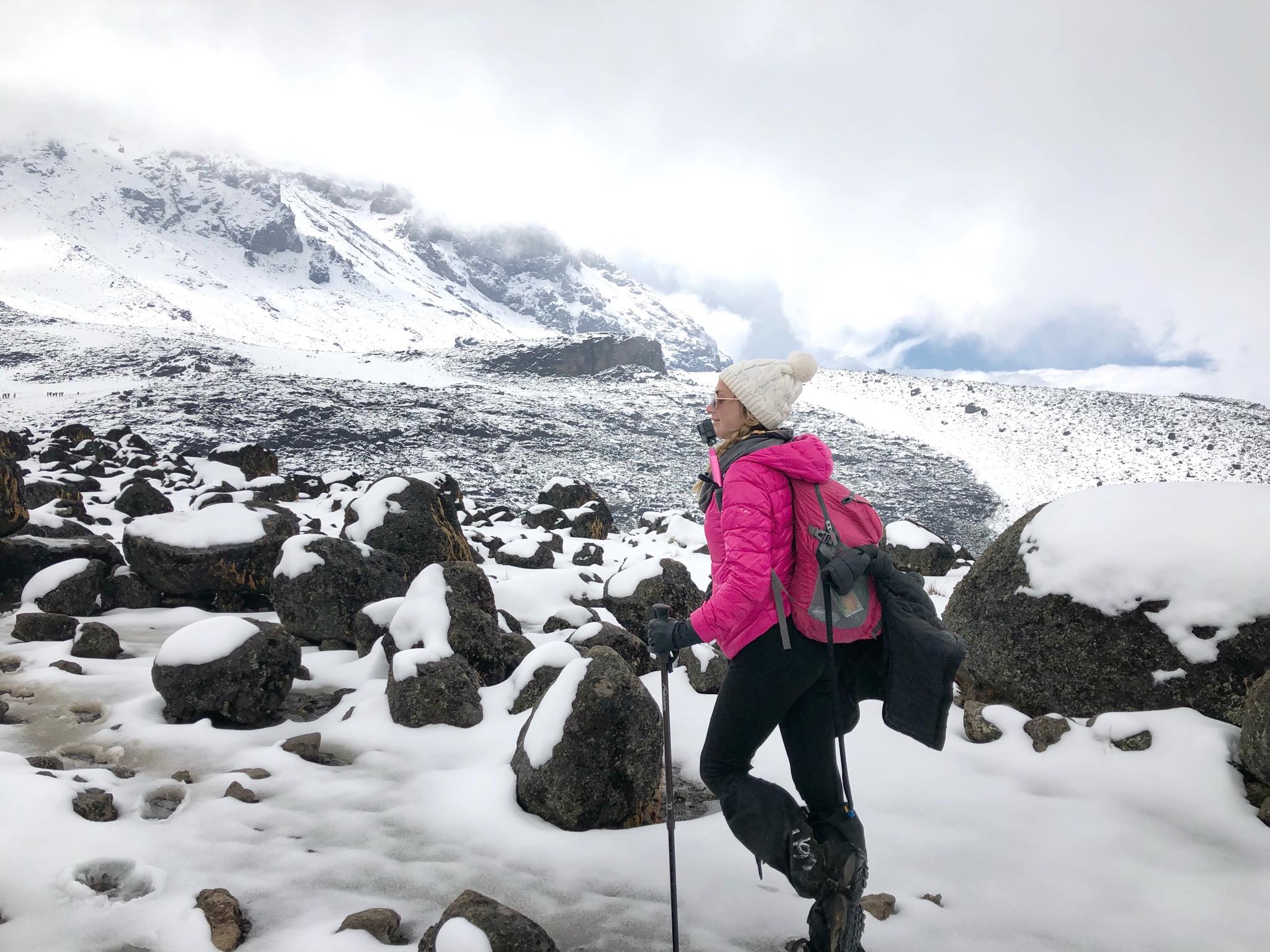
I’d never used hiking/trekking poles before and to be honest, thought they looked silly and were only for people who needed extra help. But I quickly grew to love them both because they are fun and amusing to use, and they really did help me not slip quite a few times. Especially in rain, on gravel, and in the snow.
Using them also takes pressure off your legs and knees, which is a massive help when going downhill.
42. Rent Your Trekking Gear
Unless you are a frequent hiker or camper, I wouldn’t suggest buying all new trekking gear, or even bringing your own from home unless you don’t mind lugging it across the Earth to get it to Africa and back. You can rent poles, sleeping bags, sleeping bag liners, gaiters, duffel bags, even water bottles if you need to. It’s pretty cheap and makes things a bit more hassle free…not to mention, ensures that you have the proper gear!
43. Donate Unwanted Gear & Buy Locally
Some items on the mandatory packing list weren’t rentable, so I just quickly ordered them offline. But, since I don’t have a use for snow pants, waterproof gloves, a heavy duty poncho, camping water bottle, and backpack cover in the near future, I just donated those items for either the porters or future trekkers.
I also made sure to buy all of my souvenirs directly from locals who handmade them and would profit from the sales (there’s A LOT of made-in-China souvenirs in town). I got an engraved ‘Kilimanjaro’ bracelet at a local restaurant, and a few handmade items at Shirikisha which are made by deaf or disabled women, and the proceeds help support them.
44. Be a Positive Motivation to Others
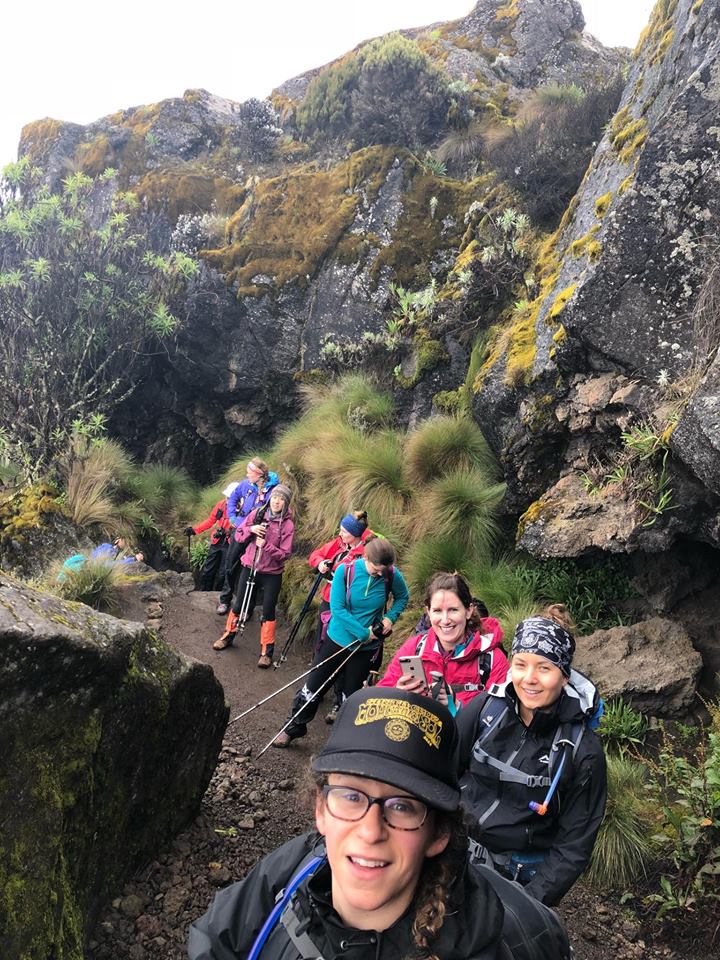
For the most part, our group of 22 women was insanely motivational and supportive of each other. There of course was the inevitable one person who thought they were a more experienced hiker than everyone else and would make little comments about my gear not being up to par with the pros (yet look who summited first and got down from the mountain first! Me!), so that’s a great example of what not to do.
We also dealt with a few guys, and other “more experienced hiker women” in other groups making little comments to us for going slow, likely thinking that because we were a big group of not-rugged-looking-women, we were having trouble. But this was all strategic in getting us to acclimate, and after summit, we were in WAY better shape than anyone else on the mountain.
45. Be Sure to Break in Your Gear
If you’re buying new gear like hiking boots, be sure you wear them around for a while before starting the trek to Kilimanjaro. Otherwise you’ll probably get a lot of blisters and be very uncomfortable! I purposely got boots that were all black and wearable as regular shoes so I could wear them in Norway before the trip, and they were super comfy the entire time!
46. Pay $2 to Have Your Shoes Cleaned After the Hike
You’ll be told to leave your money and valuables locked in your suitcase at the hotel during the hike, but I’d suggest bringing at least $20 US or the equivalent in shillings. After you finish the hike, local guys will ask if you want your shoes cleaned, and my advice is to definitely do it, because you are not going to know how to clean them yourself without getting the insides wet!
47. Bring Good “Camp Shoes”
Also on the mandatory packing list are “camp shoes”, which are comfy, close-toed shoes to wear around camp instead of your boots. Whoa suggests Crocs, and swears by them for comfort, but I couldn’t bring myself to wear them, and opted for some jelly slip-ons I found in Kenya for $3. They worked well except my feet would get cold in anything other than my hiking boots.
48. Have Designated Sleeping Socks
Your socks are going to smell offensive after every day of hiking, and you don’t want that stench and grossness back on your feet after you clean them. So designate a pair of comfy, long socks specifically for sleeping in each night, and only put them on after you’ve washed your feet in the warm water buckets your porter will bring your before meals.
49. Know How to Use Your Gear
The a-fore-mentioned know-it-all had a field day when my tent-mate and I divulged that we had no idea you’re supposed to cram your sleeping bag into it’s case instead of rolling it up. No one told us or showed us how to do it, and we aren’t avid campers, so we had no clue. That being said, if you can’t figure out how to use something, ask any of the guides or porters, they’ll be more than happy to show you and try to just do it for you.
50. Use Your Warm Water for Washing for Your Feet
One of the most glorious moments of each day was when one of the porters would bring us “warm water for washing” to our tents before meals. It’s to wash your hands and face, but since my feet always smelled and were a bit sore from walking, I also used it as a mini foot bath which was absolutely game changing.
Ready to Book Your Bucketlist Kilimanjaro Trek?! Here’s a list of Whoa treks coming up, and if you want $100 off, use my code ‘MyLifesATravelMovie’!

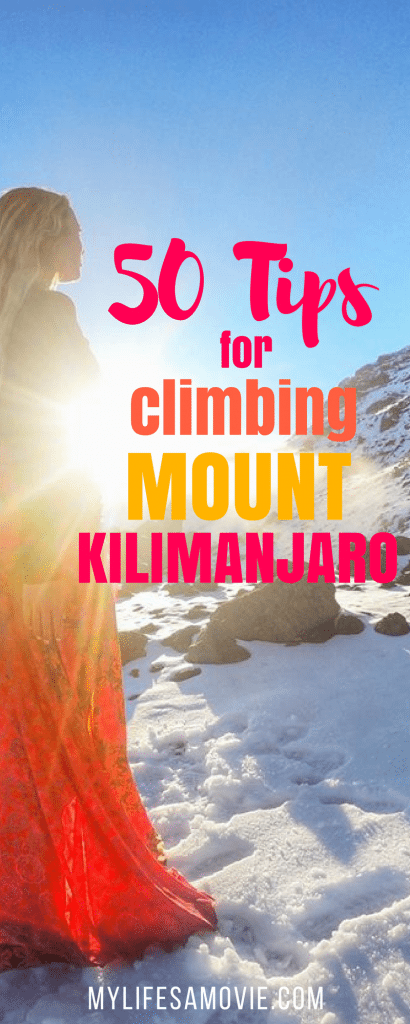
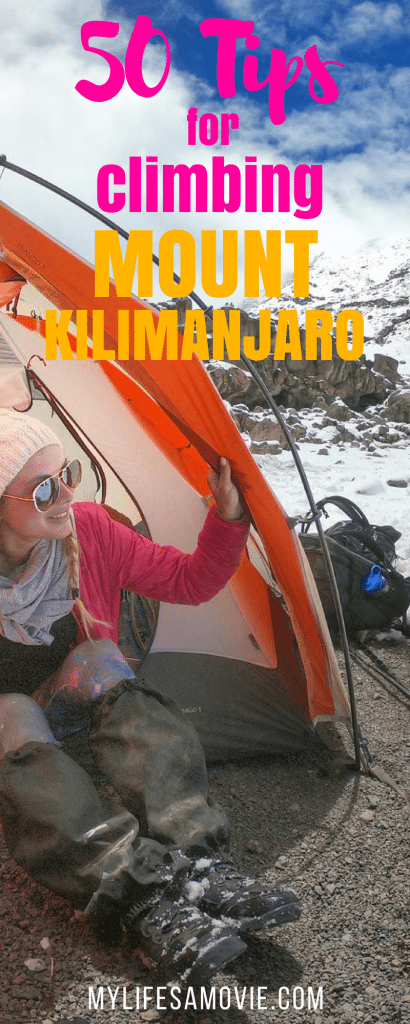

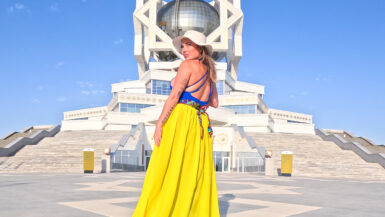
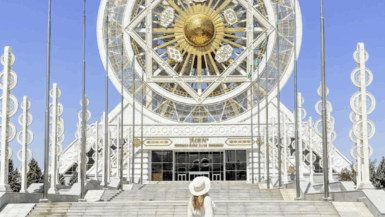
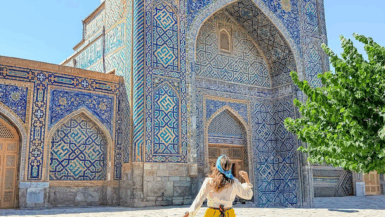
Thanks a lot for sharing such a great piece of article! I found it a good helpful write-up with a good sound and explanation. Here I have seen some valuable ideas that are definitely helpful for every climbing enthusiast. Please keep sharing more updates!
Thanks so much for reading it!
good one…
I climbed Kili in 2012 and really struggled with the altitude on the last few days when I got to lava tower-not sure if you did the same route! Luckily it was just for a day and I had a successful sumit. I’m doing everest base camp and island peak (6000m) in November and I’m reluctant to try diamox because of the bad things I’ve heard. But im so nervous that altitude gets the better of me! Did you have any effects from the diamox? And how often do you take the tablets? I havent even considered taking, but after this post I may just! And I agree with all your points, you’ve definitely covered everything! I spend 3 days in Zanzibar after my hike and it was incredible!
Yes I did the same route! I also want to do Everest basecamp next! I took diamox and LOVED it, I’m surprised you heard bad things! The side affects are just feeling some tingling in your feet or hands like they’re falling asleep, and also having to pee more frequently, but we wrote the pee stops off as extra rest breaks so it didn’t bother us much! I never felt sick once and was prancing around at the summit like a show pony haha
This looks so amazing! I bet the feeling when you reached the summit was indescribable!! I love hiking and think this looks like something I really want to do. Also, great photos!
You definitely should if you love hiking! I always say that I only hike if there’s something worth hiking to, and this summit was DEFINITELY worth it!!!
Hi Alyssa! Finally got to sit down and pull up your post about your hike. LOVED it! Your tips are so awesome and real. Thank you for taking the time to write this down.Reading it got me super motivated to get my butt in better shape to go and have more adventures, eventually leading up to this. You rock! Love how real you are with everything you share on IG/FB. Thank you! Have fun in Australia!
Thanks girl! Really appreciate you taking the time to read it and of course acknowledging the real-factor 🙂 Travel ain’t easy, but it’s more awesome if you’re prepared for the hard parts!
Sounds like an amazing experience! Climbing Kili has been on my bucket list for years, and seeing it through your blog and intsa, only makes me yearn to do it more! Thanks for sharing all the great tips and photos!
Enjoy the R&R in Dubai 🙂 xx
Thanks Georgie! I really hope you do it! It’s such an incredible experience!!
This is a great tip list, and thanks for compiling it! And I can’t believe I never thought about doing #18 with the panty liners. And that know it all lady sounds annoying AF!
Haha right?! I had listed it years ago in an article called “10 hacks for shit you forgot to pack” and was surprised (and less embarrassed) when one of the GALs on the trip mentioned it! So genius.
The panty-liners tip though! Never thought of that! I hike a lot and run a travel blog for outdoorsy women and this tip is game changing! I need to add it to my ultimate solo female hiking safety post! Also, #33 I learned the hard way lol I worked for a couple weeks on a ship to Alaska and usually only pack carry on. So I didn’t have any nail clippers. I did the hardest hike of my life to-date in Skagway Alaska and coming down the trail feels like its basically vertical and its pretty freaking steep. One of my lil toenails hurt so bad after that and a few weeks later, it just came right off! So gross!
I’m so stoked for more of your Kili posts! It’s making me seriously consider doing the hike myself. I also love that you went to Dubai to relax afterwards haha. Something so necessary to treat yourself with after that!
Omg I can’t imagine having to have gone down hill with long toenails! Even after cutting them my toes still hurt!!! And YASSSS the panty liner trick is sooooo genius! I may have to invent a literal travel-purpose type that’s not annoying to wear haha!